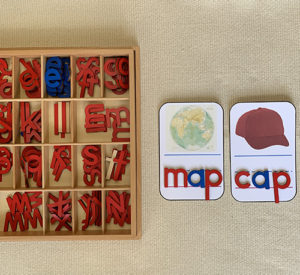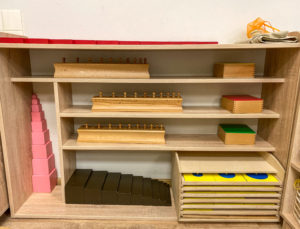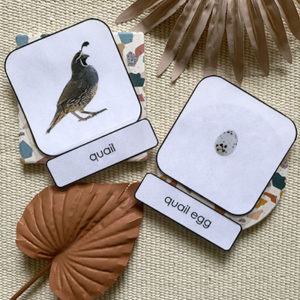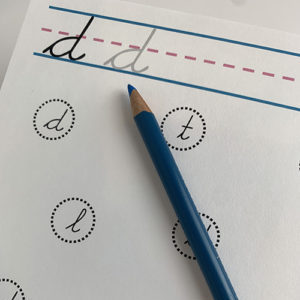When it comes to Montessori language learning, you may do things a little differently.
- You teach your child letter sounds instead of letter names
 Forget the alphabet song – you know children do not actually need to learn letter names first, even though so many early childhood books, apps, and TV shows focus on names. We don’t learn to speak, spell, and read by knowing the letter names, it’s the SOUNDS that matter most.
Forget the alphabet song – you know children do not actually need to learn letter names first, even though so many early childhood books, apps, and TV shows focus on names. We don’t learn to speak, spell, and read by knowing the letter names, it’s the SOUNDS that matter most.
The component sounds of language are called phonemes (the smallest aural component of a word) and each letter has its own phoneme.
This phoneme-level instruction is so important that it is a predictor of reading ability by third grade.
“…in a school that provides early intervention, all students experiencing reading difficulties receive intensive instruction beginning in kindergarten.” (Good, Simmons, and Kame’enui, 2001)
In Montessori language learning, phonemic awareness is the primary focus for the first two years. This preparation may help prevent reading difficulties in the future.
- You have a collection of miniature, realistic objects in your playroom
 You know kids prefer “the real thing” when given an option, and so you offer as many real experiences and lifelike replicas when possible. These “language objects” are one of the classic Montessori language materials used to introduce children to vocabulary and beginning sounds in the classroom. Children ages of 3-6 experience a sensitive period for small objects, they seem to be drawn to them and can spend a lot of time looking at them.
You know kids prefer “the real thing” when given an option, and so you offer as many real experiences and lifelike replicas when possible. These “language objects” are one of the classic Montessori language materials used to introduce children to vocabulary and beginning sounds in the classroom. Children ages of 3-6 experience a sensitive period for small objects, they seem to be drawn to them and can spend a lot of time looking at them.
Because of this innate appeal, Montessori language objects can be used in so many ways: to teach vocabulary, to play sound awareness games to learn phonemes, matching object to object, or object to picture, and more.
When a child is ready to spell, these objects can be used to spell the names of simple CVC words such as “cat”, or use “invented spelling” to phonetically spell longer words like elephant.
- You don’t use “baby talk” with your child
The quality and quantity of early language exposure can predict future vocabulary and language success. For this reason, even if you like to babble with your baby and mirror their sounds (also a great thing) you should not “dumb down” your speaking because you think it is cute, or will help them understand. Especially as your child gets older, stick to real sentences and even better if you talk about things happening in context.For example, common sense insists that it will be easier to acquire the meaning of “zebra” in the visual presence of a zebra (“There goes a zebra!”) than in its absence (“Let’s visit the zebras in the zoo”). To that extent, an environment that maximizes this “here and nowness” of speech––its high quality, or referential transparency––might be expected to boost the rate of early word learning independent of the number of times a child hears each word.
Some people worry about using large vocabulary words with children, but just think about how easily a child acquires the 6-syllable name of their favorite dinosaur tyrannosaurus rex. Don’t be afraid of using complex words, just use them in context and offer them explanations if they don’t understand.
Dr. Elika Bergelson from Duke University says, “Treat your baby like a real conversational partner,” she said. “Even young infants are listening and learning about words and the world around them before they start talking themselves, and their caregivers make that possible.”
- You get excited when your child asks, “Why?”
A classic parenting annoyance is the curious child is a child who is always asking “Why?” But you love providing answers to a child looking for information, interaction and conversation! This is the foundation of logic, ability to conduct research, explore and deepen interests. You keep a list of the questions your child asks, and use it as an opportunity to keep them engaged. You might try to find a book on the topic, find an informative video or documentary that will keep them engaged, because you never know where these inquiries can lead.But don’t worry, even if your child is not big on talking or is reluctant to ask questions you always can wonder aloud to model this behavior, “I wonder what kind of bug this is? Let’s find out!” - You need a suitcase when you go to the library

You quickly got over your embarrassment by how many books you check out at the library, and now you bring along the best tool for the job. Research shows that just having lots of books around is correlated with more success in school and work. The presence of books communicates your family’s values, and is naturally going to lead to children perusing the books and being curious about what is in them.Reading books in front of and to your child models how enjoyable literature can be. Show them that books are a big part of your family culture. Include a book as a gift for every special occasion your family gives gifts for. Donate your gently used books to those in need, or make a little library to keep the giving going in your community. - You let your child cook even when you know it could get messy
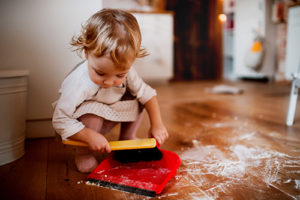 Dr. Montessori observed that children want to be involved in the daily life of the family. You know that as children learn to coordinate their movements, they are going to drop or spill things. This doesn’t upset you, and you are more than happy to let your children cook, clean, and garden alongside you even if it takes extra time or clean up.
Dr. Montessori observed that children want to be involved in the daily life of the family. You know that as children learn to coordinate their movements, they are going to drop or spill things. This doesn’t upset you, and you are more than happy to let your children cook, clean, and garden alongside you even if it takes extra time or clean up.
Cooking, cleaning, self care, taking care of the home or garden are incredibly important not only for independence and confidence, but building vocabulary, as well as strengthening the body and hands for writing. These activities are also wonderful for teaching lessons and how to positively handle consequences of our actions.
Before a child is ready to sit at a table and write, their hands, eyes and bodies need to be strong and coordinated. Did you know children today increasingly are lacking the gross motor skills needed to write and some are even falling out of their chairs at school? Let’s turn this trend around!
Not only should children play freely outdoors, but there is plenty to do in the home that will engage their bodies and minds. Just think of the strength and coordination needed to cut up vegetables, sweep a spill, pour water, mix batter with a whisk. Additionally, children learn how to understand and follow multi-step directions, and concentrate on these complex tasks from start to finish, which is a benefit for language (and again, math) skills.
- You aren’t afraid to belt a tune with your child no matter how your voice sounds
Music, poetry, rhymes and rhythm are an essential part of language development as well as enjoyment and creativity. Music is also a part of many cultures and can be a part of your child’s most fond memories. It is incredible that patients in memory care facilities who have lost the ability to speak, can often come alive when music is playing and they can remember all the lyrics. Music can help a child learn concepts, order, and vocabulary. In my own school children were having trouble with the order in which to put on all their winter gear. We had a little chart on the wall, but I also made up a short song, “Snowpants, boots, coat, hat, and gloves…” and it repeated several times to a familiar tune. The kids loved it and would sing it to remember which item came next! - You love the feeling of sandpaper on your fingers
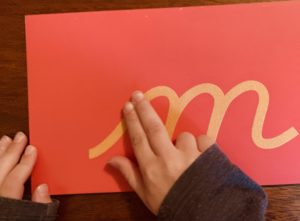
You know when a child traces a sandpaper letter and says the sound the letter makes at the same time, their brain makes a strong connection due to the multi-sensory experience. They see the letter form, they trace the letter form, they feel the sandpaper as they trace, they say the letter sound, and they hear the sound – all simultaneously. This type of multi sensory learning is the gold standard for learning a skill like reading, which does not come to humans naturally, so we should take all the help we can get. While the Montessori method was not designed specifically for children with dyslexia, this approach can be very helpful for children with dyslexia when used in conjunction with other proven methods such as Orton-Gillingham. - You don’t laugh at your child’s spelling “mistakes”
Despite the fact that when children spell phonetically it can take some time to understand what they meant to write, you don’t panic, correct, or worse, laugh at your child’s attempts. The ability to spell phonetically is a crucial early step in learning to read, spell, and write. So when your child spells cat with a “k” they are actually 100% correct because they correctly identified the sounds needed in that word.Parents ask when, “When should I correct my child’s spelling?” One trick a veteran teacher taught me that works wonderfully without making the child feel wrong is to explain there is something called “book spelling.” You simply say, “When you read this word in a book, it is spelled…” In Montessori, we progress through the rules of spelling methodically and explicitly as the child masters one skill. We eventually teach them everything they need to know, including when we need to simply memorize non-phonetic words, called sight words (or my preference, “heart words” because you memorize them by heart).



